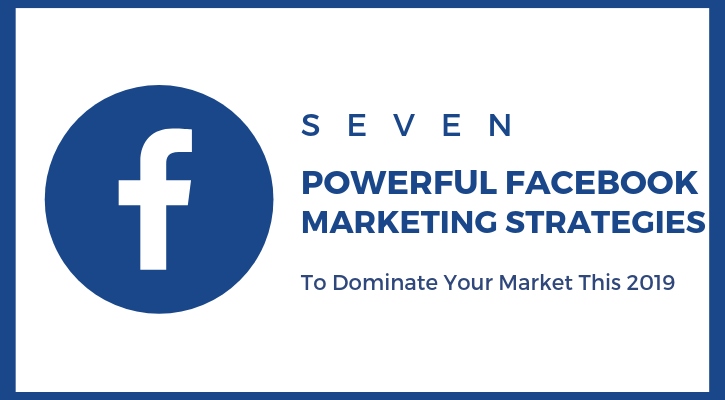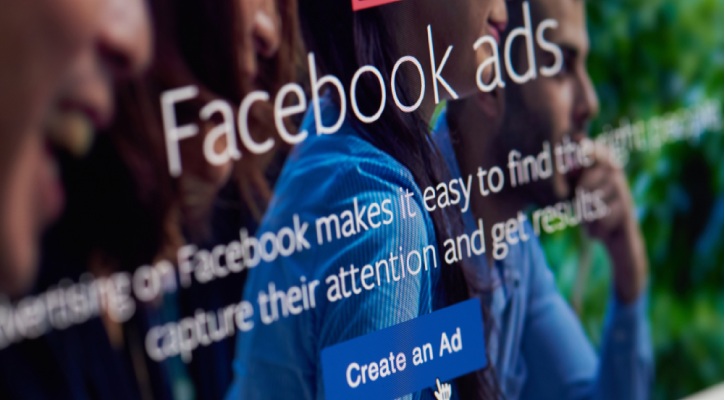The term Social Media was first coined in the late 1990’s by either Tina Sharkey, CEO of Babycenter.com and a former executive at iVillage and AOL or serial entrepreneur Ted Leonsis, then an executive at AOL. You can take your pick.
What is clear is that Social Media is now the biggest single grouping of humans on the planet. Statista currently estimates that 2.46 billion people use social media and by 2021 3.02 billion – that’s 1 in 3 of the human race!
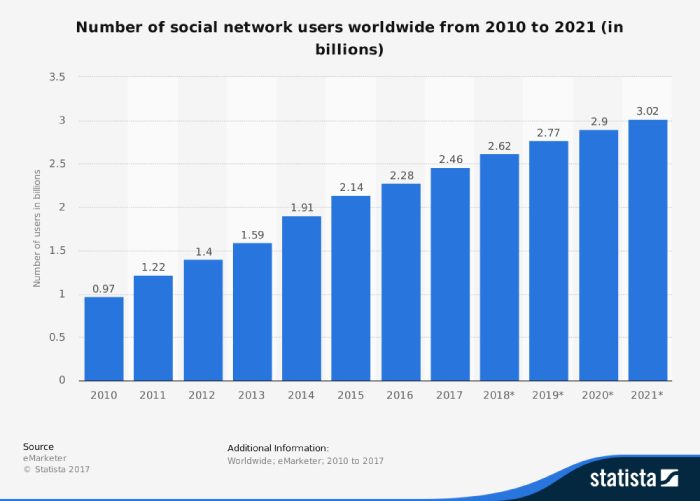
Find more statistics at Statista
So clearly marketing to this audience is the single most important challenge that any company or organization faces today if they want to get their brand message across.
So how do you go about it? What are the key steps that you need to take to have a winning social media strategy?
1. Set Social Media Goals
Setting goals is an essential step in any project or campaign – whether it be for a business or indeed for personal development. If you want to run a marathon you need to train and each week learn to run that 2 km extra to reach the goal of 42 km. If you want to run it in a given time, then you need to add in considerations about how fast you train to reach your goal on race day.
So it is with Social Media Marketing (SMM). You need to define your goals – is it about making the audience more aware of your brand, is it about going the distance and gaining more customers for a given product in a given time frame?
In Buffer’s State of Social 2016 report[1] they found that the most common goals of SMM were:
- Brand Awareness
- Community Engagement
- Content Distribution
- Sales / Leads Generation
- Customer Support

The SMM goals need to be aligned with the overall business goals. They also need to be sanity checked as well.
Increasing the interest in customers contacting with the company for customer support through social media without the appropriate resources in place would clearly not make for a corporately coherent plan.
The goal can be measured in an absolute number (3,000 new signups next quarter) or incremental (30% increase in website visits from social media). What is clear is that everything needs to be aligned.
SMART is the goto acronym for goal setting and it applies perfectly clearly to SMM as well. There are variations, but I believe that the following are the best:
- Specific – target a specific area such as the number of people engaged through SMM.
- Measurable – see how you are going to measure accurately and repeatably the number.
- Assignable – specify who will do it and who is responsible for achieving the goal.
- Realistic – check whether the goal is achievable with the resources that are available.
- Time-related – specify when the result(s) can be achieved.
2. Define Your Target Audience
Marketing cat food to dog lovers is never going to work! You need to ensure that you know who you are trying to communicate and engage with and this involves defining who your audience is for your SMM content.
The development of so-called Social Media “personas” is a method that allows for a neat and defined understanding of the types of people (yes, real people) that you want as clients.
Once you have their profiles defined you will be able to focus the content and the delivery in a way that is best suited to each group.
One of the biggest questions we get asked is where do we get the information from to be able to build the personas?
Clearly it must not be internalized otherwise they will simply be open to the distortions of the corporate marketing department. External and truly independent sources need to be used:
- Google Analytics
- Facebook Insights
- Twitter Analytics
- YouTube Analytics
- LinkedIn Groups
- Customer surveys and focus groups
- Sales staff – they know your clients better than anyone else in your organization
- Customer service staff – they deal with your clients
- CRM – you will be able to get demographics
One sanity check you need to do is to figure out whether these “personas” actually use Social Media on a regular basis. Just check the demographics for your personas.
Sprout Social have made an analysis of the demographics for different social media channels and have developed a great infographic which you should check, because if your personas are all over 55 then perhaps Instagram or Snapchat are not the channels you should choose!

6 Social Media Demographics for Marketers[2] by Sprout Social
3. Craft The Content
So you have the goals and the personas but what are you going to show them so that they make the interactions you want them to make? Content creation is not a one-off action or activity for a month – it needs to be continuously programmed.
Our Content Creation Management process is a guaranteed way to make sure that you have the right content at the right time.
The basic steps are:
- Plan and Program
- Idea Generation (ideation)
- Production
- Implementation
- Distribution
- Analysis
One of the keys to success is the variation in the types of content available to each channel. There are many ways that the message can be communicated and the format needs to suit your personas. Here are some of the content formats you can use:
- Web Pages, Articles and Blogs Entries
- Guest Blogs
- Videos
- User-Generated Content
- How to Guides
- Case Studies
- Streaming
- Infographics
- Newsletters and E-mail
- Interviews
- Customer Support Stories
- Statistics
- ‘What to do’ and ‘what not to do’ posts
- Recognise Greatness
- Repurpose Sales Presentations
- Company News
- Newsjacking
- Free resources
- Personal Bios
- News and Press Releases
- FAQS
Each of these formats can be repurposed and converted into one of the other formats. This can make sure that you get a really good flow of material even when the creative juices are running low.
Make sure that the first hits are in the formats that your personas are primarily looking for. A Video is very different to a Case Study!
4. Choose The Platform(S)
There are numerous different social media channels you can use for your SMM. Just take a look at the chart below and you will get a feel for what is out there and the number of users that they each have:

Find more statistics at Statista
Each of them however is different and requires a little investigation in terms of what is right for your personas. Their overall demographics, social status, geography will all play an important role as to which channels to choose.
So if your message is for Millenial or Xgener women then you should seriously consider Pinterest as a major channel eve though it has only 200 million users. By the way that means that you will need to publish on a Sunday morning – the key time Pinterest has traffic!
The most important issue is that the channel can be seen to add value to your campaign. If the results from Twitter are really bad even though everything was done correctly – learn the lesson!
5. Automate
Be careful that you do not choose too many channels or you may find yourself with too few resources to implement an effective campaign. Clearly there is a need for automation otherwise the tasks involved will simply be too great.
There are a number of platforms out there that will help you manage and automate the publication of your content. Hootsuite[3], Crowdfire[4], CoSchedule[5], SociAlert[6], BuzzSumo[7], Scoop.it[8], Post Planner[9], Social Pilot[10] and SproutSocial[11] are all great platforms.
My favourite (no affiliation at all!) is Buffer[12]. It is really easy to add different Social Media Accounts
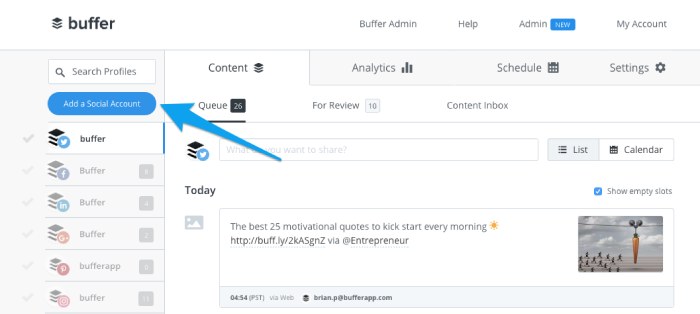
source content you want to distribute (by the way you can add your own blogs RSS feed to the sources),
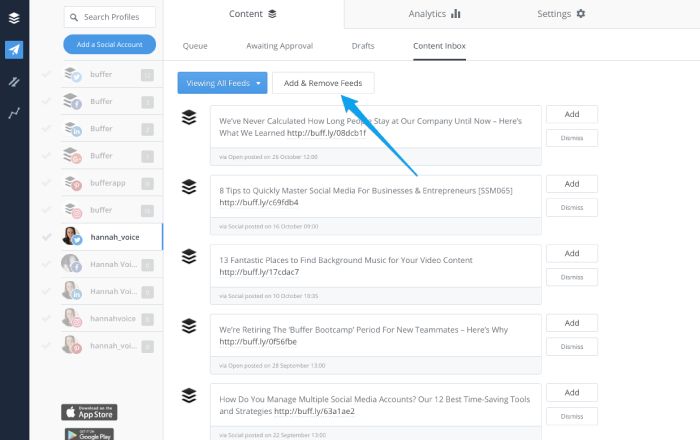
schedule at the best time
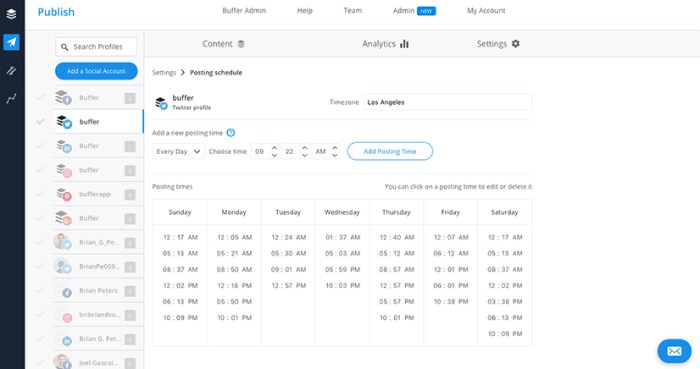
and share between members of your team.
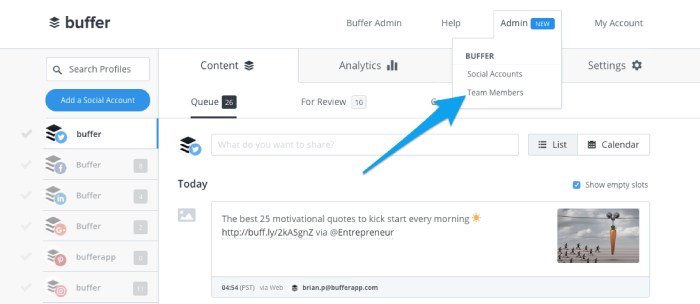
The timing and the frequency are very different for each social media channel.
CoSchedule blog put together a graphic[13] of how their social media frequency might look. They’ve scheduled specific windows of times for some of their updates to publish to their social channels, and they supplement these specific posting times with a handful of other posts that get added to the queue.
Look how this e frequencies change 8 Tweets: 6 Facebook Posts: 4 Google+ posts: 2 Tumblr posts.
That implies that you will need to prioritize content for each channel and develop more for some than others.

Be careful however of copying frequency and timing schedules. Each industry and geography are subtly different. Working practices such as long lunch breaks or working on Saturdays will affect your engagement rate.
6. Consistent Brand
Effective communication of your SMM content and brand message is not easy. Making the effort to keep your messages consistent can help you build loyalty and increase retention.
The way your “personas” respond will be more positive if you focus on the right message which is identifiable in all the channels they may touch.
The look of your brand is predominantly determined by your logo, layout, colours, font and other design elements and how they work together. Facebook and Twitter contain a ton of customization options.
Your company can create a visually stunning page which reflects your brand’s personality and message effectively. The Make a Website Hub[14] has a great Infographic to make sure that you optimise the images sizes to get the best appearance.

Social Media Images Sizes Cheat Sheet
Conflicting messages will confuse your customers and harm your brand. Hence, it is important to keep the content you share on social media channels consistent.
Don’t bombard your users with the same content again and again but keep the pace a bit varied; remember Twitter users and Facebook users expect very different posting frequencies from businesses.
Fans also do not like being constantly advertised to. Get a bit creative and utilize the power of social media creatively. Facebook and Twitter can be much more than simple promotional streams.
Clashing messages will confuse your clients and damage your brand. You need to make sure that all the content is consistent and coherent. For example, Tiffany & Co. absolutely owns their “Tiffany blue” across all of their imagery and their audience easily associates this soft blue with the brand.


There are so many social media channels where users can search for information about your brand that you need control to keep your presence consistent. If you link between them, which, by the way, you should, then you need to make doubly sure that everything looks the same and the message is the same.
Some channels can be more frivolous than others but the underlying message needs to be the same.
7. Engage
Social Media Engagement is when your followers interact with you or your brand. Typically they are seen as:
- Likes and retweets
- Mentions and replies
- Shares and link clicks
- Comments and more
- Endorsements – the Holy Grail of engagements
These types of interaction need to be measured but how can you make sure you are on top of them constantly. The fewer followers you have, the harder you must work at engaging but the more you have the more you need to engage.
Here are two cool tools that we use.
Keyhole.co
Price: Free 3-day plan / Paid plans start at $99 per month
Keyhole[17] track the use of hashtags, URLs, and keywords.
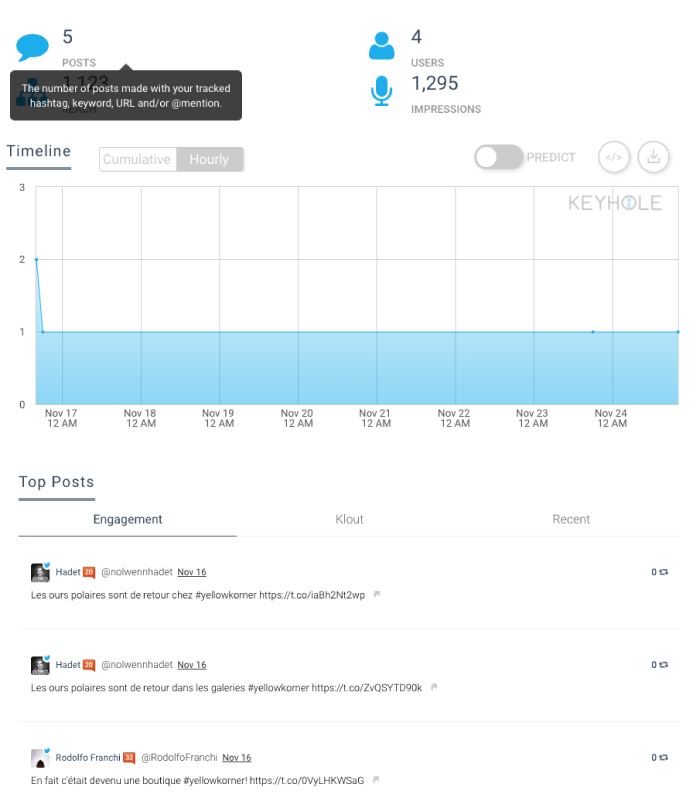
Keyhole can give you valuable insights into impressions, geo-location, and the top influencers that are using the same hashtags as you. Keyhole will also update you in real-time, so you can curate the best content to extend your brand’s reach.
tagboard
tagboard[15] is a visual way of following your brand based upon hashtags. The output is a very easy to follow using a Pinterest type of flow that allows you to see how people are interacting with your brand. It is really designed for events and it is priced accordingly.

Once you have the means to be able to follow what people are saying how can you engage?
Well simply liking the followers will be an engagement of sorts but you can a better quality engagement using other techniques such as:
- always welcome new followers and try not to automate it!
- respond to them with a positive comment or further (intelligent) questions
- make contests that require participation on line
- feature their contributions
- encourage creativity with your products
- actually ask for a like (Like if you agree with this)
We will not go into detail about influencer marketing but clearly if you identify someone with a large following that endorses your brand, make sure that everything they post on social media is distributed as though it was your own. Reach out to them, gently and see of they need anything to continue the endorsement. Maybe try and interview them.
8. The 80/20 Rule

The 80/20 rule is a universal guide for most content marketing efforts. Read more here: http://coolerinsights.com/2015/11/the-80-20-rule-content-marketing/
The 80/20 rule was first put forward by Vilfredo Pareto and referred to the observation that 80% of Italy’s wealth belonged to only 20% of the population (just out of interest in 2016, 1% of the population owned 10% of the wealth in Italy).
In fact it can be applied in many ways to Social Marketing: 20% of your posts will give 80% of your engagement for example. However that is not the main focus.
80% of the content you post to social media should be informational & entertaining content valuable to your audience, and 20% can be self-promotional. Think “educate to sell”. See one of my stories of how this works.
Overselling in today’s markets is negative. Customers are highly socially conscious and they are loyal to brands that care about the same things and values as they do. Brand saturation can turn the tables on this. Focusing too much on your products or services is guaranteed to push customers away. It’s overaggressive and not conducive to eliciting any kind of engagement.
Once you have won a following by posting valuable content, you’ll have the chance to promote your brand when you need to, for 20% of the time. You may not need to promote anything now – and that’s okay. Later, you’ll be glad you’ve built up a loyal following that will pay attention when you need to drive engagement.
9. Keep It Relevant
We often observe campaigns or SMM processes that stall. The initial rush of engagement stutters as new content becomes more difficult to find, the numbers of followers begins to plateau and engagement levels fall.
More depressing than binge watching The Leftovers (if you haven’t caught the show – it is good just make sure you have a party to go to afterwards).
Sometimes the demographics can change and sometimes you need to make sure that you understand what is currently relevant to your audience at that moment.
The University of St Andrews in Scotland got this right back in 2016. What they did was work on a small video project in November 2016 aiming to collate one word summaries of students’ thoughts regarding the US election. The following video was recorded and edited on the day of the election.
St Andrews Students on the US Election
In honour of the US going to the polls today, we asked some of our students to describe the election in one word #uselection #weareinternational
Posted by University of St Andrews on Tuesday, November 8, 2016
This type of immediacy makes your social media come alive. Think newspaper front page – in fact newsjacking articles that resonante with your marketing personas will keep the engagement high.
10. Measure & Improve
“If you can’t measure it, you can’t improve it.”
Measuring is one of the most important aspects of SMM. It is what gets you the budget spent internally and lets you know you are doing good or not so good job. It also points out what are the areas that you can improve upon.
Each of the Social Media channels have their won analytical elements:
- Facebook Insights
- Instagram Insights
- Twitter Analytics
- Pinterest Analytics
- LinkedIn Analytics for individuals and companies
- Google + Influence
Furthermore there are other services that will integrate different channels together such as Buffer[16], Cyfe[17] and Peaked[18].
You can also get an idea of what your message is coming across like. If you have a coherent marketing message across channels and Twitter is one of them, then you can analyse what your brand “personality” looks like.
The Personality Insights by IBM Watson[19] gives a reasonable idea of your posts. Here is what the Adlibweb personality looks like:
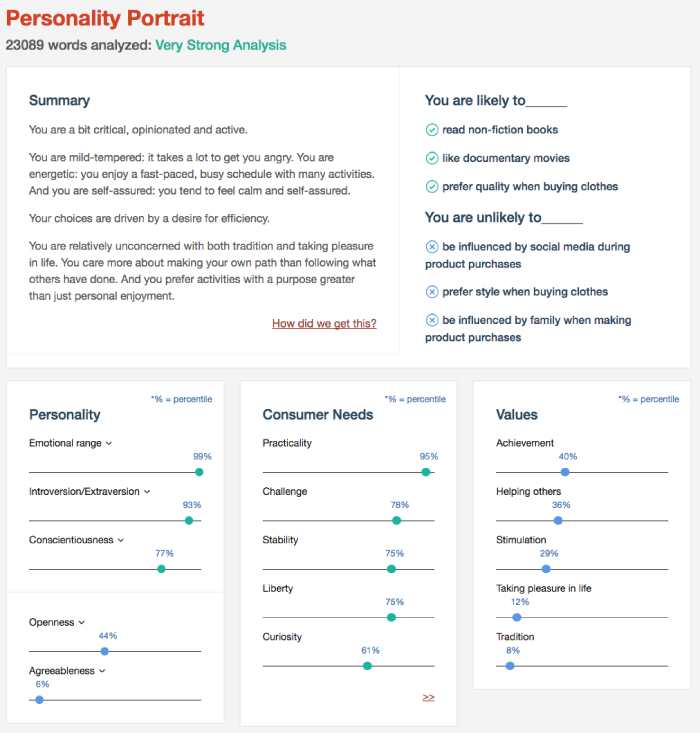
The presentation of the data is very important and there are some great free tools out there that help show you progress. The Simply Measured tools for Facebook and Instagram have some good insights into your accounts:
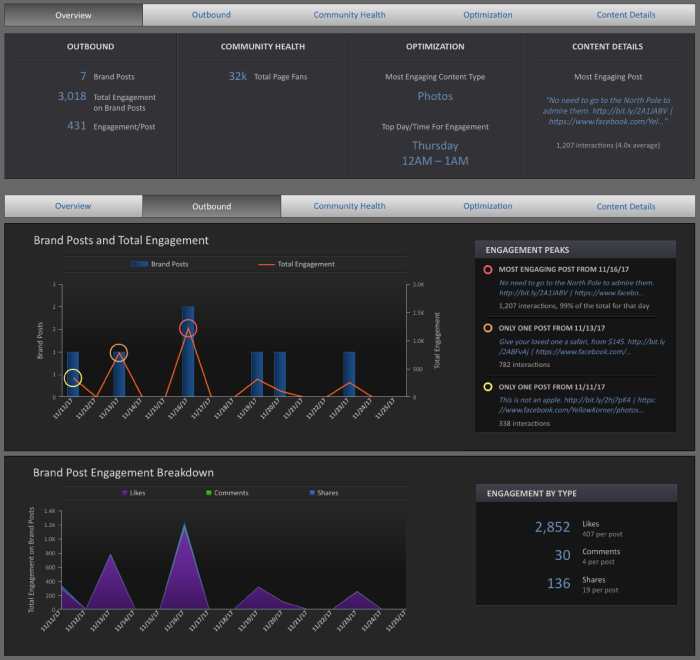
Read More: The Powerful Link Building Strategies for 2018
Conclusion
In the world where almost 1 in 3 people are active on social networks and spend at least one hour a day on those social networks, we have to conclude that social networks have become a reality where people communicate, engage, and trust. Social Media Marketing cannot be avoided and should be embraced.
Over 90% marketers already report they are using social networks for business, while more than 60% of them claim to have acquired new customers over social networks.
Having a process to communicate and engage with the users of social media channels is critical. Get the process wrong at you peril. Get it right and it will fuel your growth.
Featured Image: Shutterstock
In-Post Images: Images given by author


